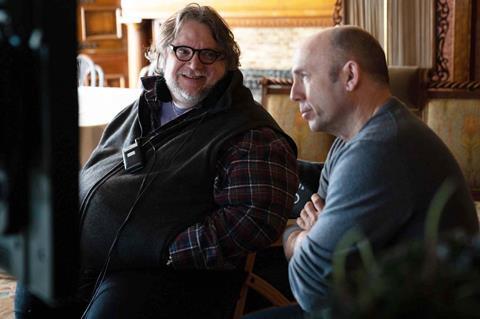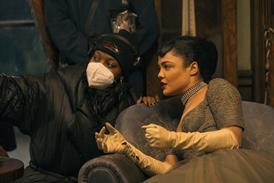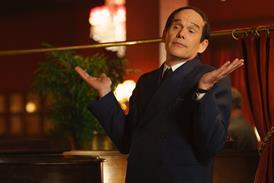After a career entwined with the supernatural, Guillermo del Toro changes pace with his first film noir, Nightmare Alley. The Oscar-winning filmmaker tells Screen about banishing the fantastical with his dark conman tale.

Guillermo del Toro has lived with monsters for most of his life.
Screen can even see some lurking behind him in his Los Angeles home during our Zoom call: shadowy, macabre, misshapen things, some of which are plucked from cinematic history, including his own movies Hellboy and Pan’s Labyrinth. “Yes,” he says, “there’s a lot of monsters here.”
The same cannot be said of his latest film Nightmare Alley. At least not in the traditional sense of monster. For the first time in his career, del Toro has left behind the supernatural, setting aside the fantastical and horror elements that have defined his output from 1993 feature directing debut Cronos through to his Academy Award-winning creature romance The Shape Of Water in 2017.
“There were a lot of decisions to be made after The Shape Of Water,” explains del Toro. “But in my filmography, there’s always been something in the next movie that scares the shit out of me, whether I’m going to try a superhero movie, or I’m going to try an intimate story of the Spanish Civil War but with fantastic characters.
“In this instance, I thought, ‘I’ve been saying all my career that the monster for me is man, not the monster. Why don’t we do just that? And why don’t we do it in a genre that I’ve loved with as much passion as I have the fantastic and horror?’”
That beloved genre is film noir, which del Toro tackled as a young man in short films, leaving a lingering desire to return to it at feature-length one day. It is, he says, with loquacious enthusiasm, “the American version of Greek tragedy. It is a cinema of desolation and existentialism that was born at that curious crossroads where America abandoned the pastoral and the spiritualism of the early 1900s, and went into the post-First World War dissolution, landing in an urban industrial environment in which brutality was systematised against men.”
Where most modern filmmakers have updated the genre into neo-noir, del Toro was determined to serve it raw. He found the ideal material in William Lindsay Gresham’s 1946 novel Nightmare Alley, the grimy tale of slick conman Stanton Carlisle, who uses techniques learned while working at a carnival to trick his wealthy marks into believing he can speak with their dead family members.
It was suggested to del Toro by his co-screenwriter Kim Morgan, who didn’t know he was already familiar with the book (previously adapted as a 1947 film starring Tyrone Power), having been given a copy by actor Ron Perlman after they worked on Cronos together.
Returning to it, del Toro was struck by its modern relevance. “We live in a time where the lines between truth and lies, and reality and belief, are all blurred, and we seem to just engage with the circular systems of belief that confirm our bias and divide us from the rest,” he says. “We’ve also seen the rise of popular hucksterism in the political arena and social media. I thought, ‘Let’s do something that seems to come from the past, but suits the emotion of today.’”
Honing the story
It was not the easiest of adaptation processes. Their first draft was an unwieldy 150 pages, even after del Toro and Morgan — who is a film critic and programmer — excised an entire episode where Carlisle becomes a preacher. “So we started trying to do everything as a character portrait,” the director explains. “Noir is great at following a character to a destiny that seems inexorable, but is always propelled by the character’s decisions. That’s the beauty of noir — it’s a destiny of our own doing.”

Yet for all its appeal to del Toro, noir is not exactly the most commercial of genres. “I have always been misguided in my efforts,” del Toro laughs. “I’ve never made a sure thing, and now I’m going for a genre that hasn’t been touched for a long while.” However, to his surprise, Searchlight Pictures, which funded The Shape Of Water (when it was Fox Searchlight), was willing to back Nightmare Alley. “They said, ‘You need to make it for a number, and you need to get a star or two.’ So we stuck to that number and brought in so many stars that it was impossible for them to say no!”
Those names include Cate Blanchett as string-pulling psychologist Lilith Ritter, Rooney Mara as Carlisle’s much-better half Molly, Toni Collette as carnival clairvoyant Zeena and David Strathairn as Carlisle’s alcoholic mentor Pete. For a time, Leonardo DiCaprio circled the role of Carlisle, but ultimately it landed with Bradley Cooper. “Physically he embodies Gary Cooper, almost,” says del Toro. “He looks and feels like a ’30s or ’40s star, and I had inklings of him being able to go fearlessly into the dark side of his life, after seeing A Star Is Born and Limitless.”
Most importantly, having insisted to the studio that the film’s stark coda was non-negotiable — “Without the ending, there’s no movie” — del Toro was relieved to find Cooper valued it as much as he. “Of course, he’s an actor but he’s a director and he’s a storyteller. He saw the power of that ending and embraced it. He said, ‘The whole movie is a product of the last two minutes.’ I am fortunate that Bradley Cooper exists.”
During production, the collaboration between del Toro and Cooper became so tight that it engendered a major shift in the director’s shooting methodology. “He’s a director that acts,” says del Toro. “It was a partnership that was quite moving for me to discover, and it changed the way I shoot things.”
How so? “Normally, I do little pieces, editing on camera. But while I was watching Bradley act with Cate Blanchett, all of a sudden, I was watching a movie and I didn’t want to cut. I stopped seeing Bradley, I was just watching Stanton and I thought, ‘Jesus, it’s so much better shooting this way, letting the actors try the whole scene every time.’ It rendered a certain truth that I’m very satisfied with. Now I will never shoot a movie the way I used to.”
As fruitful as the process proved, it was also, del Toro says, “the hardest movie I ever shot”. Partly, this was the result of “playing chess with a pandemic” — which forced a six-month shutdown halfway into production — and partly the result of “sub-zero temperatures and hurricane-level winds” hitting the set, particularly the carnival they built for real, down to every period detail, outside Toronto. But it was also the challenge of nailing the tone. “I wanted the movie to have a certain heightened visual reality that made it almost like a fable or a nightmare, if you’ll pardon the pun. I needed to keep it real and invoke certain elements of genre. It was a very difficult balancing act.”
Del Toro’s next film does not sound like it has been a much easier experience. “We’ve been shooting for a long, long time now,” he says of his stop-motion Pinocchio, directed jointly with animator Mark Gustafson. “We’re about 60% finished and we’ll be done shooting by around April. It’s a project that’s been with me for between 10 and 15 years now.
“Two stories that are two sides of the same coin, the yin and the yang, are Pinocchio and Frankenstein, which both represent something very personal to me. Pinocchio questions what makes us human. What is it to be a puppet in world of humans that behave like puppets? Because it’s set during the rise of Mussolini in Italy. But the tone is witty and beautiful… And it’s a musical.” He laughs. “Again, a very irrational proposition!”
At least it takes del Toro back into the familiar realm of the fantastical, as will his mooted return to ambitious HP Lovecraft adaptation At The Mountains Of Madness, a passion project that fell apart in 2011. “I have declared my will to rewrite it and try again, but it’ll be a few years, and these decisions have always been above my pay grade,” he says. However, del Toro does sign off with a promise:
“The monsters are coming back!”























No comments yet